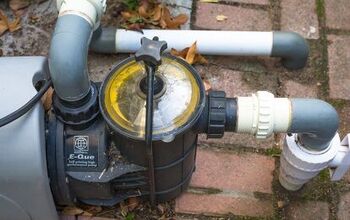What To Do With Old Pool Filter Sand (Do This!)

The typical sand pool filter holds 250 pounds of sand or more at any given time. This can be a lot of materials to handle at once, which is why it’s important to know what you can do with it once it’s time to replace it.
Old pool filter sand should not be reused in the filter itself, but it can be very helpful for a variety of landscaping projects and as an alternative to salt for your walkways throughout the winter months. If you simply want to get rid of it, you can either bury it or take it to a disposal site.
You will have to replace your pool filter sand every three to five years or so, which means you won’t have to deal with you’re going to have to know how to handle that large amount of sand at some point or another.
Do You a Need Pool, Spa, or Hot Tub Contractor?
Get free, zero-commitment quotes from pro contractors near you.

What does Pool Filter Sand Do?
The point of a pool filter is to clean your swimming pool’s water. A sand pool filter keeps your swimming pool clear of debris and bacteria by sifting the dirty water through 250+ pounds of sand and then sending the clean water back into the pool. Here are some of the main advantages of pool filter sand:
- Removes very small particles of dirt and debris
- Simple to operate and maintain
- Relatively inexpensive
- Filters both in-ground and above-ground pools
Alternative Uses for Pool Filter Sand
Just because your old pool filter sand can’t be used again in the filter doesn’t mean it’s completely useless. Before you start looking for ways to get rid of it, consider saving it for these two purposes down the road:
Landscaping Projects
While breathing in the dust from pool filter sand is harmful for people, it’s not bad for your plants. This makes it great for laying foundation for walkways and a wide range of other landscaping projects. For example, you can use it as an underlayment for paving stones and fillers between stones. Furthermore, you can fill holes in the lawn or you garden with it, too.
Driveway and Walkway Salt
When winter rolls around and the ground becomes slick, pool filter sand can be a great substitute for pavement salt. In fact, the average sizes pool filter will have the equivalent of about seven bags’ worth of salt. So, you can save yourself money and a trip to the store. If you’re able, hold on to your sand and coat your walkways and outdoor steps to avoid slips and falls.
How to Dispose of Pool Filter
If you don’t want to hold on to your pool filter sand, there are ways to get rid of it. Most people will just pile the sand in their yard until they find a way to get rid of it, but you should avoid doing this at all costs. Since the sand does contain contaminants, it’s important to dispose of it correctly.
Bury It in the Ground
One of the easiest things you can do with your old pool filter sand is to bury it. If you choose to do this, be sure to stay far away from any drainage areas before breaking ground. Otherwise, water can wash it into the ground and create a hole that you will have to cover with even more topsoil. You’ll also have to make sure its deep enough, so none of that sand can become unearthed and contaminate the air.
Go to a Disposal Site
The other way to dispose of pool filter sand is to take it to a disposal site. Since pool filter sand is full of harmful contaminants, you should not simply dump it in the trash. Hiring a professional is the best way to ensure you properly take care of old sand.
Why You Should Not Reuse it in the Filter
To ensure the best filtration for your pool, you should change your pool filter sand every three to five years. This will change depending on how often you run the filter and how clean your pool stays throughout the year.
The point of pool filter sand is to sift debris and other contaminants out of the water in order to constantly supply your pool with fresh water. This type of sand is particularly rough, so it can easily catch bacteria and debris. Over time, the items it catches will wear the sand down, rendering it ineffective over time. Plus, reusing the sand can lead to contamination of your pool.
The smoother the sand gets, the dirtier the water will become. This means your filter will require more backwashing, which is the process of flushing contaminants from the filter to prevent clogs.
Related Questions
What are the main types of pool filters?
The main types of pool filters under which every model can be categorized are sand filters, diatomaceous earth filters, cartridge filters, and pocket filters. Glass pool filters are another newer option that many people choose now, too.
How does pool filter sand differ from sandbox sand?
Pool filter sand is very small when compared to sandbox sand. It’s also coarser and is made strictly of crushed silica quartz. Play sand, on the other hand, is made from a wide range of minerals. The silica dust from pool filter sand can be fatal when inhaled. This is one of many reasons why it should not be used in sandboxes.
How much does it cost to maintain a pool?
On average, you can expect to pay approximately $1,850 per year to maintain your pool, This includes cleaning, repairs, and additional upkeep costs. Overall costs will vary depending on what type of pool you have and where you live.
Do You a Need Pool, Spa, or Hot Tub Contractor?
Get free, zero-commitment quotes from pro contractors near you.

Final Thoughts on Old Pool Filter Sand
While you can’t reuse pool filter sand in the filter itself, you can use it for landscaping projects and as a pavement salt substitute. If you are planning to hold on to your old pool filter sand for these purposes, be sure to store it in a safe and well-contained area that is out of reach from pets and children. If you would rather dispose of it quickly, you can either bury the sand or drop it off at a disposal site to get rid of it.

I am a copywriter and editor based in the Las Vegas area with nearly a decade of experience under my belt writing landing pages, cost guides, blog posts, newsletters, case studies, and social media content. I have a degree in Strategic Communication and experience working in both the account and creative spheres. My goal is to always be discovering new interests and bettering myself as a writer and editor along the way.
More by Kerry Souder



























